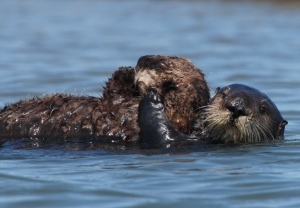The California sea otter population in 2015 has reached its highest level since fur traders hunted otters to near-extinction in the 19th century. But prospects for recovery of the threatened species are much more complicated than the numbers imply.
A recent spike in sea urchins, a favorite prey item for sea otters, may be partly responsible for this year’s higher count, according to U.S. Geological Survey (USGS) researchers. At the same time, there’s growing concern that bites from white sharks are killing high numbers of sea otters at the northern and southern ends of their range – precisely the areas where the population must grow to expand into historic sea otter habitat along the California coast.

“There’s much more to the story here than the main finding would suggest,” cautions Dr. Tim Tinker, a research ecologist who leads the USGS sea otter research program, in collaboration with the Monterey Bay Aquarium sea otter team and other colleagues. “We’re looking into various factors that may be affecting the survey results.”
In 2015, the three-year average of the population reached 3,054 animals. Under the current federal recovery plan, to be considered for removal from threatened status, the average sea otter count must be more than 3,090 animals for three consecutive years.
Even if they come off the threatened species list, sea otters would be safeguarded as a depleted species under the Marine Mammal Protection Act. The recovery plan estimates at least 8,400 animals represents the lower end of an “optimum sustainable population” in California.

“Seeing the population increase is encouraging, but we believe success will only come when we have a fully recovered and sustainable population of sea otters as part of a healthy marine ecosystem along the entire California coast,” says Andrew Johnson, the aquarium’s sea otter program manager.
For more than 30 years, our research program has worked to understand the critical role sea otters play in the health of coastal ecosystems, in California and throughout the sea otters’ range around the Pacific Rim. Sea otters have long been recognized for their vital role in restoring and maintaining healthy kelp forests. Now we and research colleagues are learning that they’re doing the same in coastal wetlands.
In addition to our research program, we’re actively working to support policies that protect and restore coastal habitats that this iconic keystone species depends on for its recovery.

Along with conducting the annual population survey, USGS scientists annually update a database of sea otter strandings: the number of dead, sick or injured sea otters recovered along California’s coast. In 2014, scientists from the California Department of Fish and Wildlife, USGS, the aquarium and other institutions recovered or documented 386 stranded sea otters.
These data are shedding new light on sea otter population ecology along different parts of the coast. For example, a high proportion of sea otter carcasses recovered between Cayucos and Pismo Beach in recent years have white shark bite wounds – a potential explanation for the downward trend in sea otter numbers in that area.
“Before the early 2000s, we didn’t see very many shark-bitten otters south of Monterey,” says Mike Harris, a biologist with the California Department of Fish and Wildlife. “Shark bite cases now explain about 70 percent of the total strandings in this area.”
Sea otter research by governmental agencies in California is funded in part through voluntary contributions by taxpayers when they file state income tax returns. The fund was inspired by a legislator’s family visit to our sea otter exhibit in 2005. To date, it has generated more than $2.7 million for sea otter field studies and other recovery efforts.
Learn more about our sea otter work.
Read details about the 2015 population survey.
Photo of sea otter raft in Elkhorn Slough © Jane Vargas-Smith.

It’s great news that their population is growing! Especially when sea otters are a keystone species.
I’m interning for some whale biologists at Glacier Bay National Park in Alaska and there are a lot of sea otters up here. Their population has grown exponentially in recent years, and that’s a good thing. However, some people here now want to kill the sea otters because it is more difficult to catch crabs. I think that it’s ridiculous. Please tell me what you think!
LikeLiked by 1 person
Super happy to read something about the recovery of such a keystone species!
LikeLike
I am from Fort Fisher.
LikeLike
so cute
LikeLike